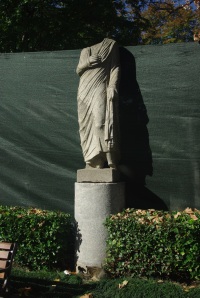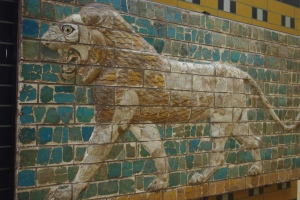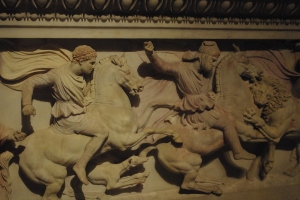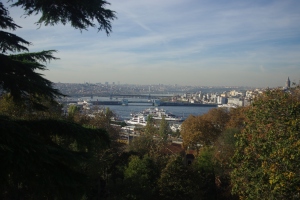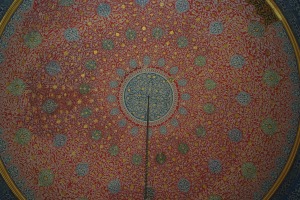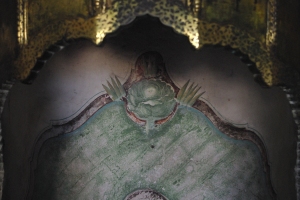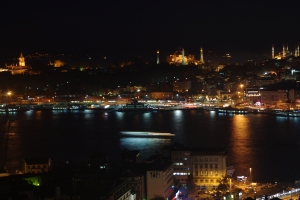Before I started to write this I had a look at the itinerary and thought, ‘Hmm, that doesn’t look like much’, and so I asked my partner how we spent our second day. Then he told me, and I remembered. We did quite a lot in fact.
The morning began as planned (after a delicious breakfast including dried figs which I now miss) with a stroll to the Istanbul Archaeological Museums. As with many places in Europe the grounds were scattered with assorted columns and statues that would have been on display in Australia, another example of how commonplace history is in the ‘old world’.
Inside the first museum we saw items from the Ancient Orient, including, excitingly, the Hittites and Babylonians. Lion statues and reliefs were abundant, including the Ishtar Gate of Babylon, which I am amazed has survived in such good condition. I can imagine the impression they must have made all those years ago, as they still do today.
More excitement came from the various cuneiform tablets, including one with the treaty from the battle of Kadesh. This was between Ramses II (or the Great, I think he’d have preferred that) of Egypt and Hattusili III of the Hitties, and is the earliest known international peace treaty. Excitement! For further information about why this is exciting to me, see the Rameses series by Christian Jacq, which I adored as a child.
The second of the museums was the main building, which included a lot of Greek and Roman items, including the Alexander sarcophagus. It wasn’t used by Alexander, who as far as I know was preserved in honey in a glass sarcophagus and was last heard of in Alexandria (or possibly Broome, Western Australia), but features his image alongside the former occupant, who was probably a governor of Babylon. It’s a beautiful monument and amazingly intact with traces of paint that give an idea of how colourful it must have been. The detail is also very fine, down to the expressions on the horse’s faces and the cloaks that look as though they’re about to ripple in the wind. There were many other sarcophagi, mostly from a burial ground in Sidon and carvings from tombs, including one of a pet dog called Parthenope who was deeply missed.
Further exploration revealed Greek and Roman statuary, mosaics and part of one of the snake heads from the Delphic column.
By this stage we were getting hungry so we left the company of ancient relics and headed into the sunshine so seek out some food. Just around the corner was the next item on the itinerary, the Topkapi Palace, as well as a cafe, shops and lawns full of people enjoying the sun. There were also quite a few stray dogs lazing in the sun, and even more cats wandering about or watching passers-by with typical cat indifference. Food eaten and energy replenished, we headed into the Palace, avoiding the long queues due to the multi-pass tickets we’d bought the day before. Already proving their worth!
The Palace is massive, and without a map or a guide we are a bit of a loss as to where to head for first. The one criteria we mostly stuck by was avoiding the places that had long queues, which served us well. For a while we wandered, peering into kiosks and out over the city and the Golden Horn.
It was warm and sunny and a very pleasant day to get spent wandering ancient rose gardens and stepping into cool, dim and beautifully decorated rooms at our own speed. I can imagine spending many hours sitting comfortably on one of the couches under the stained glass windows, happily reading books and possibly even being waited upon. It wouldn’t be too bad at all.
We also explored the Harem, which gave us more of an idea of the day to day life of people living in the palace. The hierarchy of the Harem was made clear by the placement and opulence of rooms, though we only saw the fancier ones, belonging to the Queen Mother, Princes and Chief Wife. Yet more examples of fine tiling, paintings, stained glass windows and graceful architecture. Plus a cabbage in a fireplace, for which there was no obvious explanation.
After leaving the Palace I recalled that there were supposed to be Byzantine ruins somewhere nearby, so we set off in search of them. The search was to no avail, though it did result in delicious pomegranate juice and more wanderings through the ancient streets.
When we had been peering down at the city from Topkapi Palace I’d spotted Galata tower, tall and conspicuous among the tenement buildings and wondered what the view would be like from up there. So as the day began to trail away we headed across the Golden Horn on a tram, and then up the hill on foot. I would have preferred it the other way around to be honest, as it was a very definite hill that was not playing around with gradually sloping sides. The streets of the hill were also labyrinthine, with scuffed signs to the tower, though in the end we followed a couple who were obviously tourists and seemed to know where they were going.
When we made it to the top the tower suddenly appeared, soaring upwards, and at it’s base was a long queue curling around out of sight. Resigned by now to queues, we joined it and slowly made our way back to the tower. The highlight of the wait was a popcorn seller, with a metal tray that looked something like an old fashioned bed-pan, which he shook over a fire to pop the corn inside. A with some other salesmen I’d seen in Istanbul, it seemed as though he’d happened across the popcorn tin by chance and then discarded his job at the local shop to hit the streets.
The interior of the tower was a bit of a surprise. On the outside it was an ancient stone tower, and on the inside was a gift shop and an elevator, plus a restaurant near the top. I think you can take the stairs all the way to the top, if you really want to. Three flights were enough for me. By the time we reached the top the sun had set and all around us were the lights of the city. Back across the Golden Horn I could make out, from left to right, Topkapi Palace, the Hagia Sofia and the Blue Mosque, huge and lit up even in the busy city. It was an impressive view from every angle so we took a while walking around, experimenting with our cameras and getting in the way of all the other people doing the same.
We got to the ground feeling quite hungry, but before we left this side of the Horn there was one place that had been recommended to me, so we headed off to find another tram.
Taksim square, when I first saw it, seemed to be designed for large gatherings of people, and situated in the heart of Istabul it’s no wonder that it’s been the location of demonstrations over the years. It’s a huge, open area, surrounded by streets going off in all directions, and in the middle stands the Monument of the Republic. The area there seemed blessedly free of (other) tourists so we got a feel for a place for the locals, inhabited by a locals, who were being themselves. By this stage we were getting very hungry and there was another recommendation that I had to follow, which happened to be back across the Horn in Sultanahmet, around the corner from the hotel.
So we caught a funicular tram heading down the hill, which was fun, and then more mundane ones as we reached familiar streets. The restaurant turned out to be very good, and my partner got to experience a local dish which is presented in a clay pot on fire. The pot is sealed at the top with foil and the server makes a great display of tapping the sides, and then dashing the top onto the ground. Watching the show and carefully stepping over the shattered clay, a few other tourists also decided to try it, so we got a few more displays as the night went on. Full of delicious food and drink (yes, including more apple tea) we headed back to the hotel and prepared for an early wake up the next day, in order to catch the bus for a day trip to the place where many Australia’s make their pilgrimage – Gallipoli.
In the next update will be Gallipoli, from the now calm beaches to trenches and places that look far too small to have been the resting places of thousands of people.

